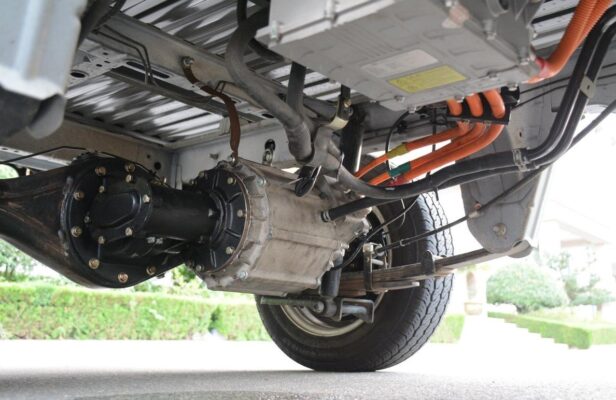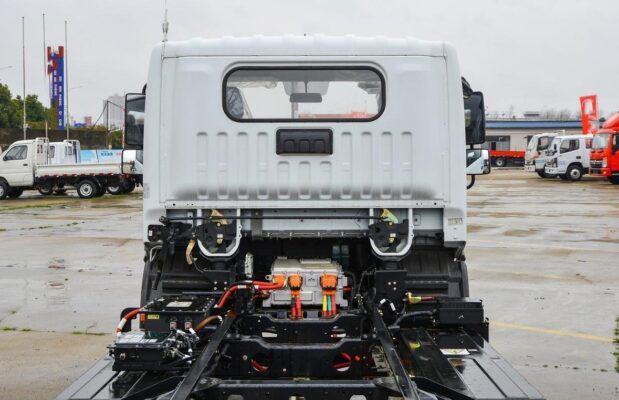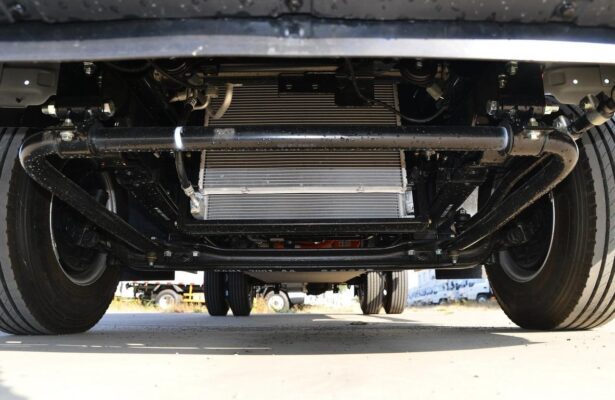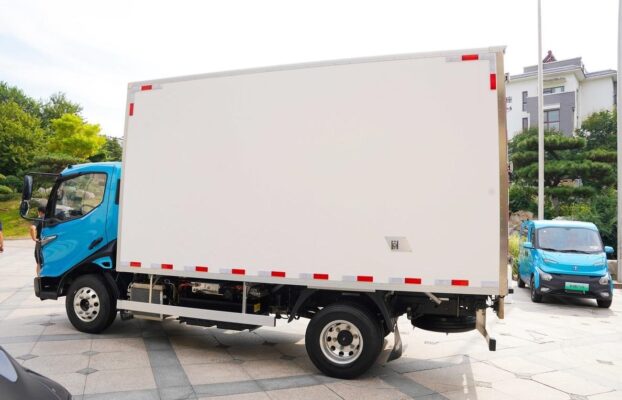Elektrisches LKW -Wissen
Structural Classification and Model Selection of Dump Trucks
Veröffentlicht am von Elektrische LKWs
Structural of Dump Trucks
Dump trucks are mainly composed of hydraulic tilting mechanisms, compartments, frames and their accessories. Among them, the hydraulic tilting mechanisms and compartment structures vary among different refitting manufacturers. The following explains the structure of dump trucks in terms of the type of compartment and the lifting mechanism.
- Compartment Types
The types of compartment structures can be roughly divided into ordinary rectangular compartments and mining bucket compartments (as shown in the following figure) according to different uses.
Ordinary rectangular compartments are used for transporting bulk goods. The rear panel is equipped with an automatic opening and closing mechanism to ensure the smooth unloading of goods. The thickness of the compartment plates of ordinary rectangular compartments is: 4-6 for the front panel, 4-8 for the side panels, 5-8 for the rear panel, Und 6-12 for the bottom panel. Zum Beispiel, the standard configuration plate thickness of the ordinary rectangular compartment of the Chengli brand dump truck is: 4 for the front, 4 for the sides, 8 for the bottom and 5 for the rear.
Mining bucket compartments are suitable for transporting large-sized goods such as large stones. Considering the impact and collision of the goods, the design shape of mining bucket compartments is more complex and the materials used are thicker. Zum Beispiel, the standard configuration plate thickness of the mining bucket compartment of the Jiangnan Dongfeng dump truck is: 6 for the front, 6 for the sides, 10 for the bottom, and some models have some angle steels welded on the bottom plate to increase the rigidity and impact resistance of the compartment.

Ordinary rectangular compartment Mining bucket compartment
- Lifting Mechanism Types
The lifting mechanism is the core of a dump truck and is the primary indicator for judging the quality of a dump truck.
The common types of lifting mechanisms in China at present are: F-type tripod amplification lifting mechanism, T-type tripod amplification lifting mechanism, double-cylinder lifting, front-top lifting and double-sided rollover, as shown in the following figure.
The tripod amplification lifting mechanism is the most widely used lifting method in China at present, suitable for a load capacity of 8-40 tons and a compartment length of 4.4-6 Meter. The advantages are mature structure, stable lifting and low cost; the disadvantage is that the closing height between the bottom plate of the compartment and the upper plane of the main frame is relatively large.
The double-cylinder lifting form is mostly used on 6X4 dump truckS. A multi-stage cylinder (generally 3-4 stages) is installed on each side in front of the second axle, and the upper fulcrum of the hydraulic cylinder acts directly on the bottom plate of the compartment. The advantages of double-cylinder lifting are that the closing height between the bottom plate of the compartment and the upper plane of the main frame is small; the disadvantage is that the hydraulic system is difficult to ensure the synchronization of the two hydraulic cylinders, the lifting stability is poor, and the overall rigidity requirement of the bottom plate of the compartment is higher.
The front-top lifting method has a simple structure, the closing height between the bottom plate of the compartment and the upper plane of the main frame can be very small, the vehicle stability is good, the pressure of the hydraulic system is small, but the stroke of the front-top multi-stage cylinder is large and the cost is very high.
The double-sided rollover hydraulic cylinder has good stress, small stroke and can realize double-sided rollover; but the hydraulic pipeline is more complex and the incidence of rollover accidents during lifting is higher.

F-type tripod amplification lifting mechanism T-type tripod amplification lifting mechanism
Double-cylinder lifting Front-top lifting
Double-sided rollover
Model Selection of Dump Trucks
With the development of dump trucks and the improvement of domestic purchasing power, dump trucks are no longer the all-purpose dump trucks that can do any job in the traditional sense. From the design perspective, different products are developed for different goods, working conditions and regions. This requires users to provide specific usage conditions to the manufacturer when purchasing vehicles.
- Chassis
When choosing the chassis, it is generally considered in terms of economic benefits, wie zum Beispiel: the price of the chassis, loading quality, overload capacity, fuel consumption per hundred kilometers, road maintenance fees, etc. In addition, users also need to consider the following parameters of the chassis:
① The height of the upper plane of the chassis frame from the ground. Generally, the height of the upper plane of the 6×4 chassis frame from the ground is 1050-1200. The larger this value, the higher the center of gravity of the entire vehicle and the easier it is to cause rollovers. The main factors affecting this value are the diameter of the tires, the arrangement of the suspension and the height of the main frame section.
② The rear overhang of the chassis. If this value is too large, it will affect the lifting stability of the dump truck and cause rollover accidents during lifting. This value is generally between 500-1100 (except for side-tipping dump truckS).
③ The entire vehicle is properly matched and reliable for use. This includes the compatibility of the engine, transmission, and axle, as well as the overall quality and reliability of the chassis components. A well-matched chassis ensures efficient power transmission and reduces the risk of breakdowns.
Let’s take a look at an example. Suppose a user intends to purchase a dump truck for transporting construction materials in a mountainous area. Given the challenging terrain and frequent steep inclines, a chassis with a lower center of gravity would be preferred to enhance stability and reduce the risk of rollovers. Zusätzlich, a chassis with a more robust suspension system capable of absorbing shocks and maintaining stability on uneven roads would be ideal.
Now, let’s delve deeper into the model selection considerations for dump truckS.
- Engine
The engine is the heart of the dump truck and its performance directly affects the vehicle’s power, fuel economy and reliability. When selecting an engine, factors such as power output, torque, fuel type and emission standards need to be considered.
Power and torque are crucial for a dump truck, especially when dealing with heavy loads and uphill climbs. A more powerful engine can ensure the vehicle’s smooth operation in demanding conditions. At the same time, fuel type also influences operating costs. Diesel engines are commonly preferred for their higher torque and fuel efficiency, but in some regions with strict environmental regulations, gasoline or alternative fuel engines may be necessary to meet emission standards.
Zum Beispiel, if the dump truck is mainly operating in an urban environment with strict emission requirements, an engine that complies with the latest emission standards would be a priority. Auf der anderen Seite, if the vehicle is going to be used in long-distance transportation on highways, an engine with high power and fuel economy would be more suitable.

- Transmission
The transmission system plays a vital role in transferring the engine’s power to the wheels. Common transmission types include manual, automatic and automated manual transmissions. Manual transmissions offer greater control and are often preferred by experienced drivers, while automatic transmissions provide ease of operation, reducing driver fatigue. Automated manual transmissions combine the advantages of both and are becoming increasingly popular.
The choice of transmission depends on the driver’s preferences, driving conditions and the intended use of the vehicle. In stop-and-go urban traffic, an automatic or automated manual transmission can make driving more comfortable. Jedoch, for heavy-duty applications and drivers accustomed to precise gear shifting, a manual transmission might be the better choice.
- Axles
The axles of a dump truck need to withstand heavy loads and harsh road conditions. Strong and durable axles are essential for ensuring the vehicle’s carrying capacity and reliability. When choosing axles, factors such as load-carrying capacity, axle ratio and braking performance should be taken into account.
A higher axle ratio can provide better acceleration, while a lower ratio is suitable for higher-speed cruising. The braking system of the axles also needs to be efficient to ensure safe stopping, especially when the vehicle is fully loaded.
Imagine a situation where a dump truck is frequently operating in a mine with heavy loads and rough terrain. In such a case, axles with a high load-carrying capacity and a robust braking system would be indispensable to ensure safe and efficient operations.
- Reifen
The tires of a dump truck have a significant impact on its traction, stability and durability. Different tire types and sizes are available to suit various working conditions. Zum Beispiel, off-road tires with deep treads are suitable for unpaved and muddy roads, while highway tires are designed for smooth pavement.
The load index and speed rating of the tires should also match the vehicle’s intended use. Choosing the right tires not only improves performance but also reduces wear and the risk of tire-related failures.

- Body Materials and Finish
The body of the dump truck, including the compartment and frame, should be made of high-quality materials that can withstand corrosion, abrasion and impact. Stainless steel or reinforced alloys are often used for enhanced durability. The finish of the body should also be smooth to reduce drag and facilitate the unloading of materials.
- Electronics and Safety Features
Modern dump trucks are equipped with various electronic systems and safety features such as anti-lock braking systems (ABS), electronic stability control (Esc), and rearview cameras. These features enhance the vehicle’s safety and handling, especially in challenging driving conditions.
Abschließend, the selection of a dump truck model requires a comprehensive consideration of multiple factors. Users need to carefully assess their specific needs, working conditions and budget to make an informed decision. By choosing the right combination of components and features, a dump truck can be tailored to provide optimal performance, reliability and safety, thereby maximizing productivity and minimizing operational costs.
In the future, as technology continues to advance, dump truck models are likely to incorporate even more advanced features such as autonomous driving capabilities, connected vehicle technologies and alternative power sources. This will further transform the industry and offer new possibilities for improved efficiency and safety.
Zum Beispiel, autonomous dump trucks could be programmed to operate in specific mining or construction sites, reducing the risk of human error and improving productivity. Connected vehicle technologies could enable real-time monitoring of the vehicle’s condition and performance, allowing for predictive maintenance and reducing downtime.
Darüber hinaus, the development of electric or hydrogen-powered dump trucks could help reduce the environmental impact of these vehicles, especially in areas where emissions regulations are becoming increasingly stringent.
Zusammenfassend, the field of dump truck model selection is constantly evolving, and staying updated with the latest trends and technologies is essential for making the best choices in this important aspect of the transportation and construction industries.